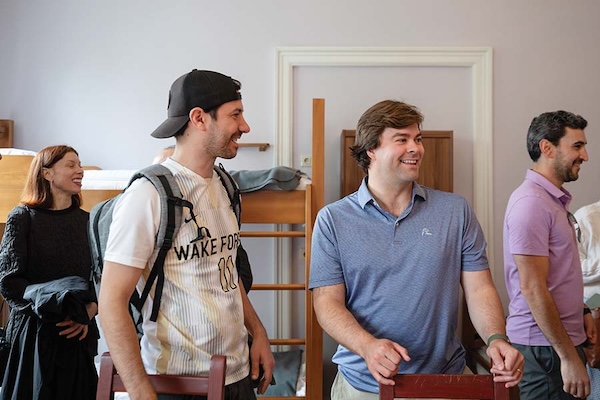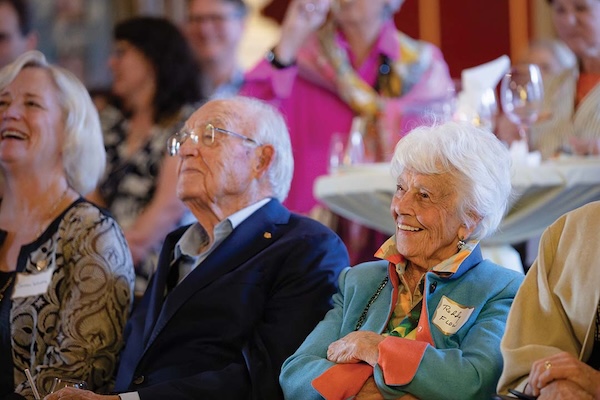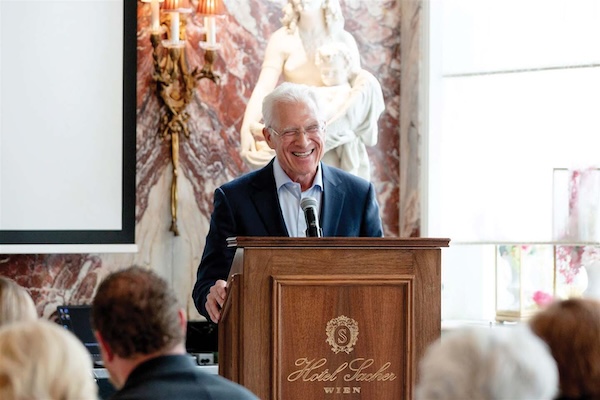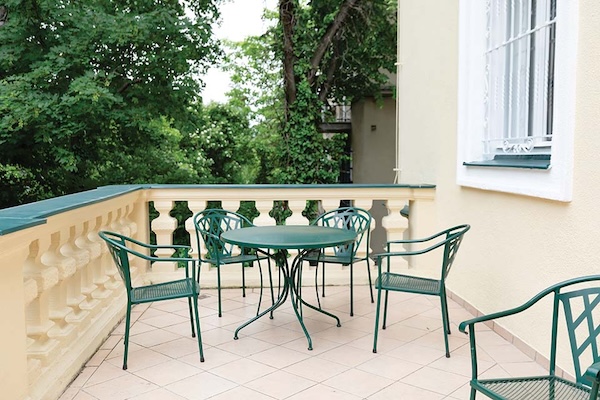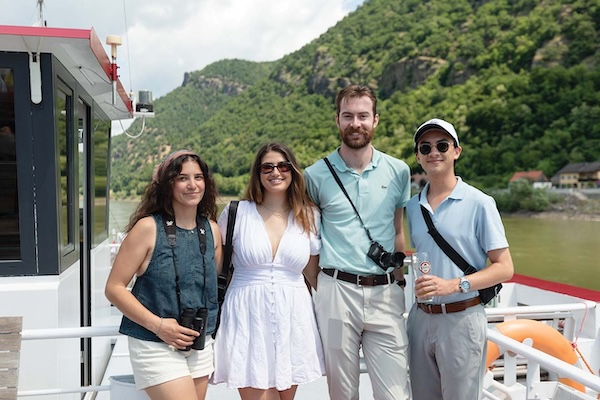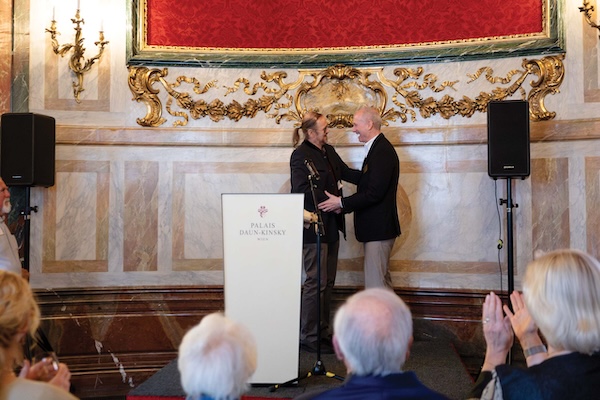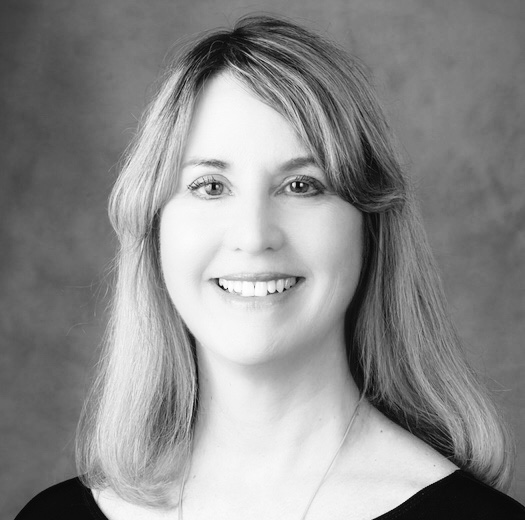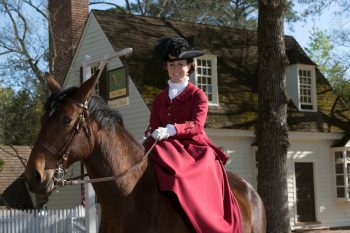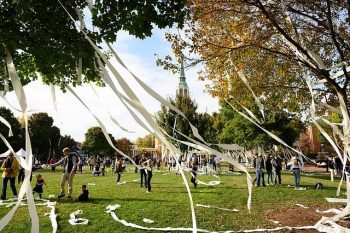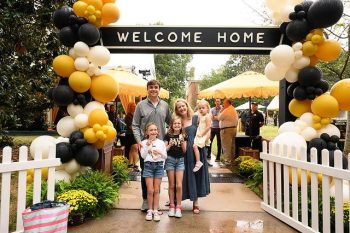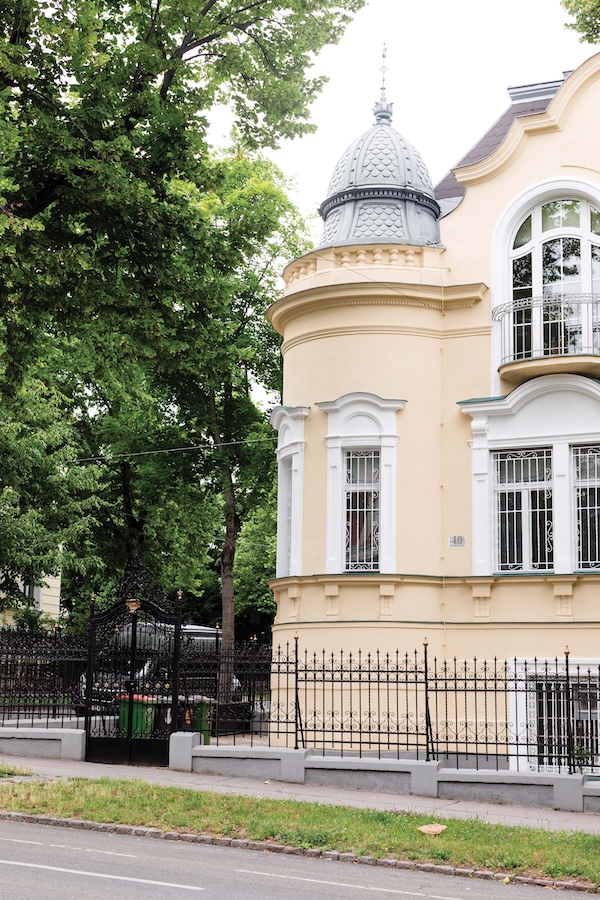
In this story:
- A Central European Treasure
- The History of the Flow House
- Alumni Reflect on How Flow House Offered Lessons Beyond Books
- Retirement for ‘a model of the teacher-scholar’
Vic Flow (’52, P ’83) and his wife, Roddy Flow (P ’83), still indefatigable travelers in their 90s, journeyed to Vienna in late May to celebrate the 25th anniversary of the study-abroad program that they made possible for more than 800 Wake Forest students and counting.
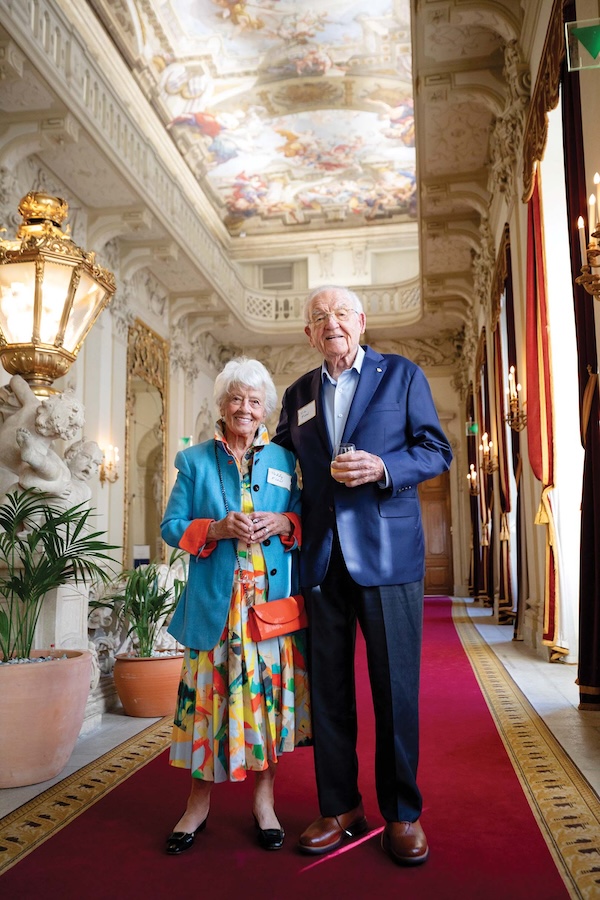
The Winston-Salem couple met or reconnected with alumni who joined them in the Austrian city for three packed days honoring their namesake Flow House, an elegant, three-story villa acquired by the University and opened in fall 1999, thanks to the couple’s donation.
Alison Delaney (’04) returned with her husband, Aaron Bokros (’02), and she remembers the Flows visiting during her fall semester in Vienna in 2002. She was struck that they “believed so much in what the University did for their family or the community or both” that they devoted their resources for students.
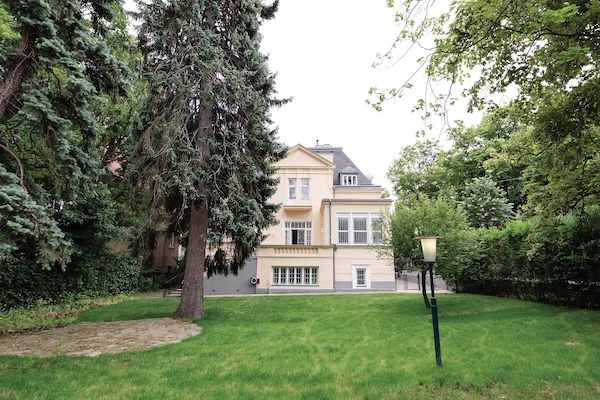
“To have them enjoy that experience and see us and ask us questions and for us to be able to thank them was really special,” she says.
Gratitude was a theme throughout the gathering of alumni, faculty, staff, administrators, trustees and friends. President Susan R. Wente, then-Provost Michele Gillespie, Associate Vice President and Vice Provost for Global Affairs J. Kline Harrison, among others, offered remarks on their pride in the Vienna program.
Flow House joined Casa Artom in Venice and Worrell House in London to make Wake Forest a rarity among U.S. universities in having three of its own study-abroad houses where faculty teach. Wake Forest perennially ranks in the top five U.S. universities in the percentage of its undergraduates — more than 80% — who study abroad for some duration.
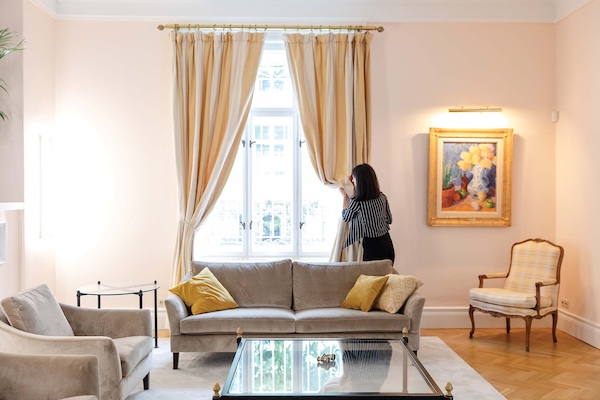
Whirlwind of Events
Guests enjoyed Vienna’s treasures up close. The first day included a tribute luncheon for the Flows hosted by University Advancement at the historic Sacher Hotel, home of the original Sacher-Torte chocolate delight. An evening reception brought guests to the dramatic Palais Daun-Kinsky, a Baroque family residence built by an Austrian noble between 1713 and 1719, with opulence envied even by the imperial court at the time. Visitors climbed a regal red-carpeted staircase to the oval ballroom adorned with gilded stucco and a ceiling fresco by famed Italian artists. Aperitifs sparkled as guests laughed and renewed connections.
The next morning, tours of Flow House showcased a just-completed remodeling of the villa, built in 1896-97 in Vienna’s leafy 19th District, the “Cottage Quarter,” a neighborhood of cozy homes, impressive mansions, diplomatic residences and green parks.
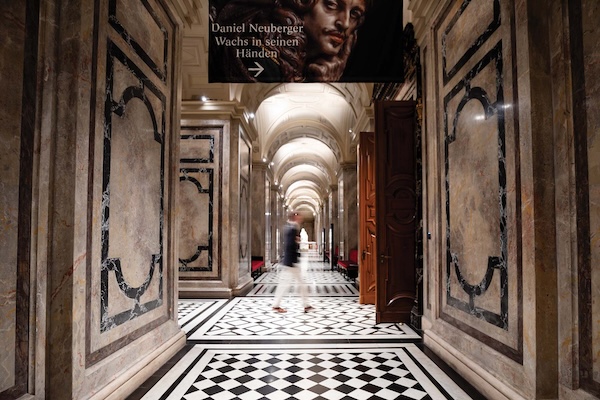
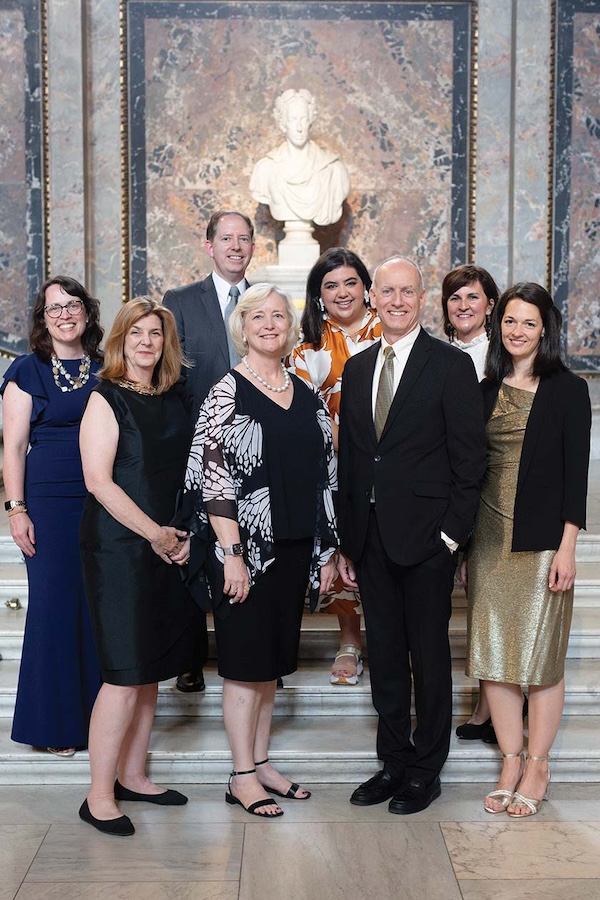
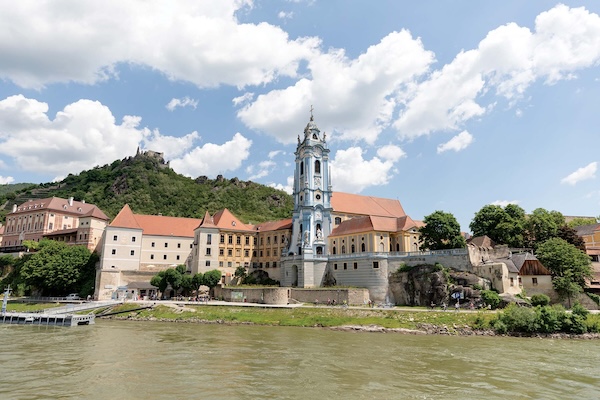
Above: Inside Vienna’s Kunsthistorisches Museum. From left, Leigh Hatchett Stanfield (‘98), executive director of Global Engagement and Administration; then-Provost Michele Gillespie; David Taylor (MALS ‘11), assistant dean of Global Study Away Programs; President Susan R. Wente; Samantha Perrotta (’12), chief of staff for the provost’s office; Associate Vice President and Vice Provost for Global Affairs J. Kline Harrison; Kim Snipes, event manager for the Center for Global Programs & Studies; and Flow House On-site Director Martina Anghel. The view from guests’ Danube River cruise.
Alumni scoped out their former bunks in the five dorm-style rooms that house up to 16 students on the top floor. They sipped Viennese coffee and nibbled treats in the kitchen where students cook meals together, learning culinary diplomacy and refrigerator détente.
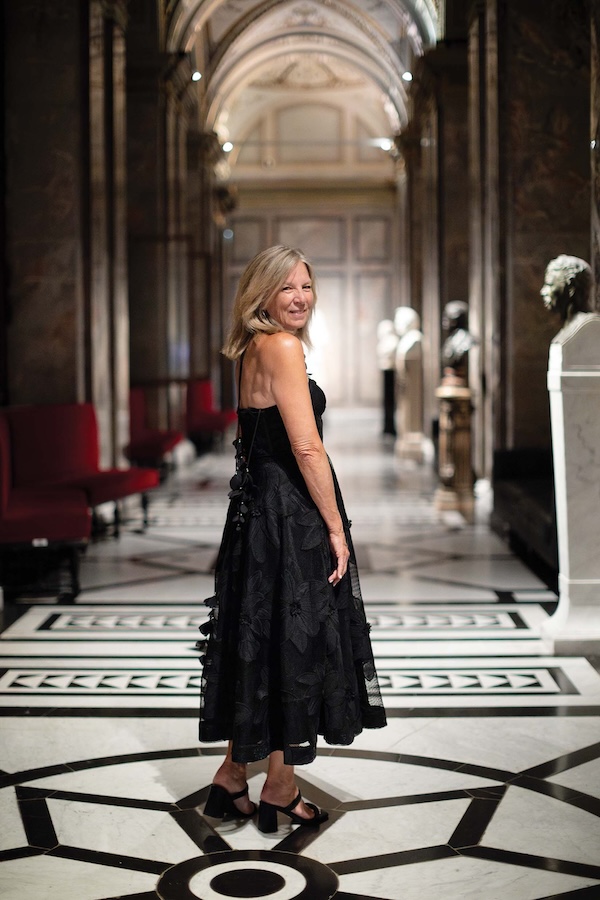
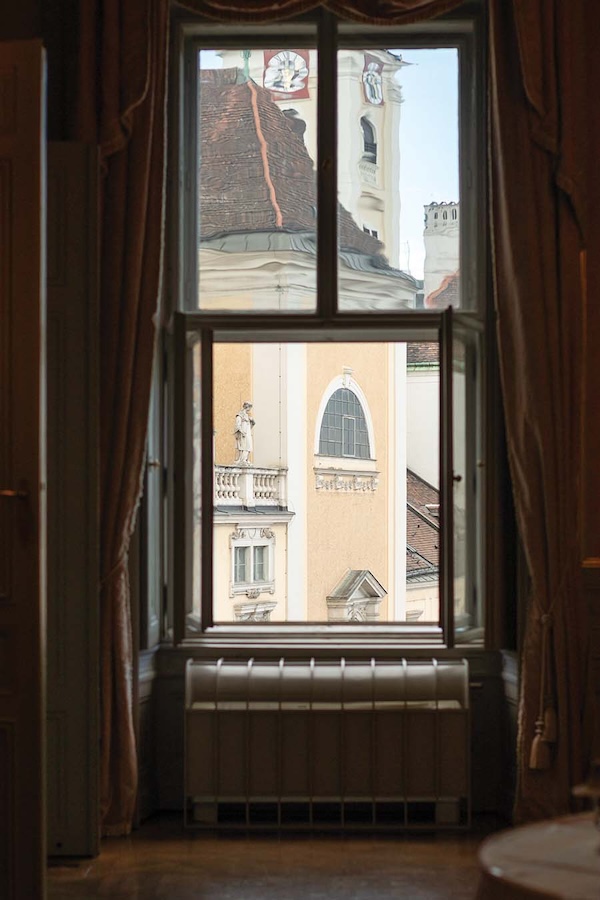
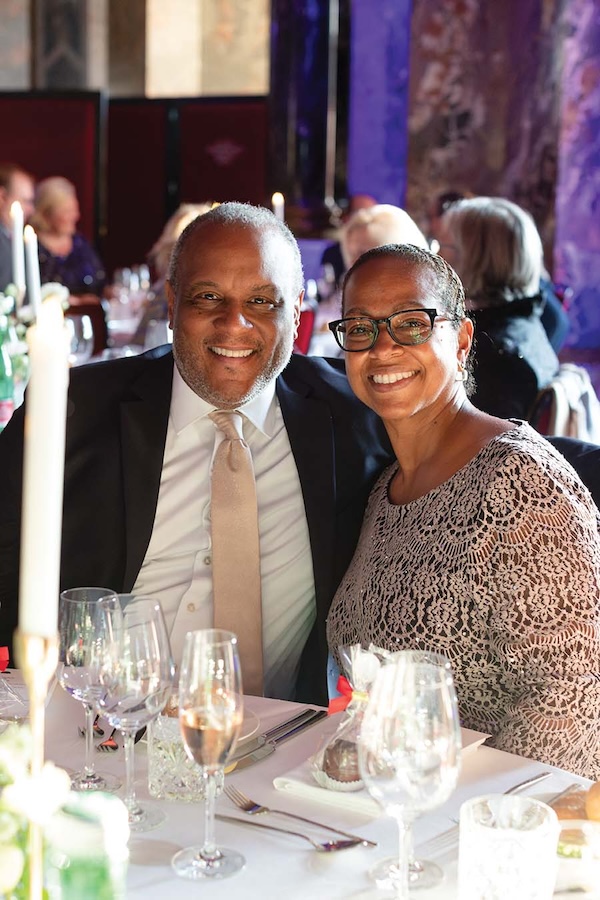
Professor Emeritus of German and Flow House Program Director Rebecca Thomas (P ’04, ’12) at Kunsthistorisches Museum; A window in Palais Daun-Kinsky; Paula Gentius, secretary of the University Board of Trustees and director of the board office, with her husband, Geoffrey Brown, at Kunsthistorisches Museum.
Culture Cornucopia
Guests chose how to spend Friday afternoon from a tantalizing list of tours and events by Wake Forest and Austrian faculty experts: the history of coffee house culture at the 152-year-old Café Landtmann? Or the culture and economics (and beer garden) of the Prater, an amusement park on former imperial hunting grounds donated for public use in 1766? Science and celebrity graves in Viennese cemeteries? Or the Museum of Military History, with the car and clothes of Archduke Franz Ferdinand and his wife from their 1914 assassination that set off World War I?
Music lovers in the City of Music, the birthplace of Franz Schubert and the Waltz King, Johann Strauss II, could take a tour of Stadtpark monuments to musicians and attend a classical concert.
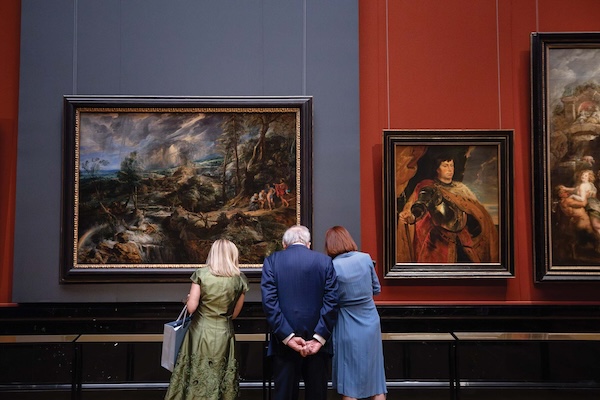
Or they could enjoy a Flow House piano recital and commentary about works by Mozart, Beethoven, Schubert and Brahms by beloved Professor Emeritus of Music Peter Kairoff, director of Casa Artom for 25 years.
Rather than looking skyward at cathedral spires and palace towers, Günter Haika, retiring from Flow House, offered an eye-level view, an eclectic mix of historical lore and hidden gems in his native city. Haika pointed out often overlooked monuments, including one installed in 2014 to commemorate thousands of soldiers in Hitler’s military who died for refusing to carry out Nazi horrors. Humor also flowed freely. He offered an explanation for the name of an area of bars, restaurants and narrow alleys and streets called the Bermuda Triangle. He said the name emerged when police began receiving a flurry of missing-person reports because bars in the area decided it was more lucrative to ignore a curfew and pay the fines for letting “missing” drinkers stay late.
On Friday night, a formal dinner brought glittering guests to Kunsthistorisches Museum, with majestic architecture rivaling its extensive collections — from ancient Egyptian and Greek art to 17th- and 18th-century paintings by such artists as Rembrandt, Rubens and Caravaggio to Habsburg dynasty objects through the early 20th century. A break before dessert allowed time for guests to wander the exhibits.
The celebration closed Saturday with a cruise on the Danube and a vineyard tour — with gratitude for reconnections and rekindled memories in what is also known as the City of Dreams.
Carol L. Hanner retired in 2024 after a newspaper career and nearly six years as managing editor of Wake Forest Magazine. She lives in Porto, Portugal.
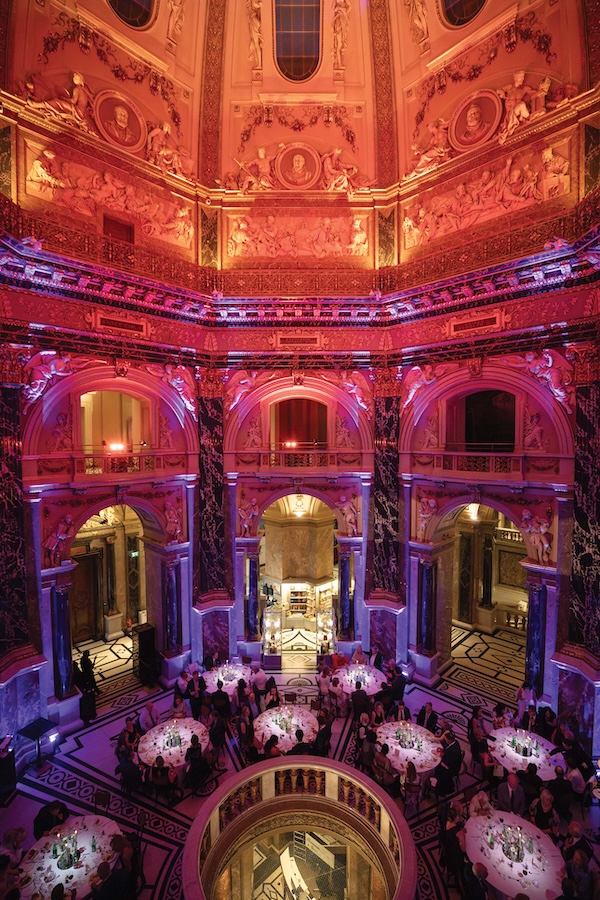
The History of the Flow House
HOW WAKE FOREST came to buy a late-19th century Vienna mansion for a study-abroad program starts with the vision of the late President Thomas K. Hearn Jr. (L.H.D. ’04) and a partnership with Vic Flow (’52, P ’83) and his wife, Roddy Flow (P ’83), of Winston-Salem. They all shared a love of travel and an appreciation of Central Europe’s importance.
A donation from the Flows allowed Wake Forest in 1998 to buy Villa Schleiffelder that became Flow House, built in 1896-97 for Otto Schleiffelder, head of an optical firm, and his American-born wife and four children.
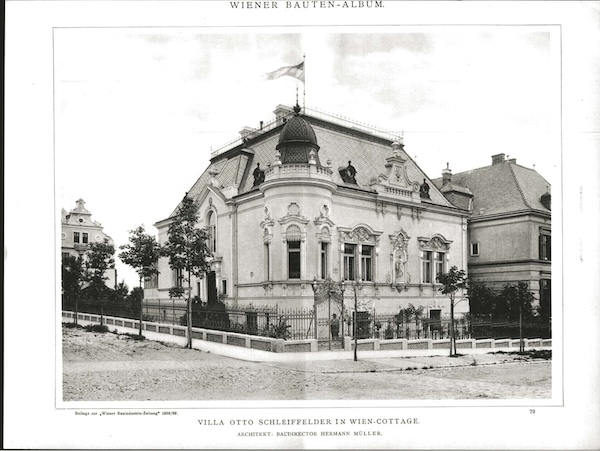
The Flows had German-speaking ancestors and had traveled extensively for business and pleasure in Germany and Austria. In Vienna, they found “education, music, art, commerce, all the things we were interested in,” Vic Flow says.
Hearn envisioned Central Europe as the best place for a third study-abroad program in addition to Casa Artom in Venice and Worrell House in London.
The last private owner of Villa Schleiffelder sold it in 1950 to the U.S. Embassy, which used it for a variety of purposes, perhaps homes for lower-tier diplomats or the CIA. In the Cold War, the United States and the Soviet Union expanded staffing in Vienna, a historical center of espionage at the edge of the Iron Curtain.
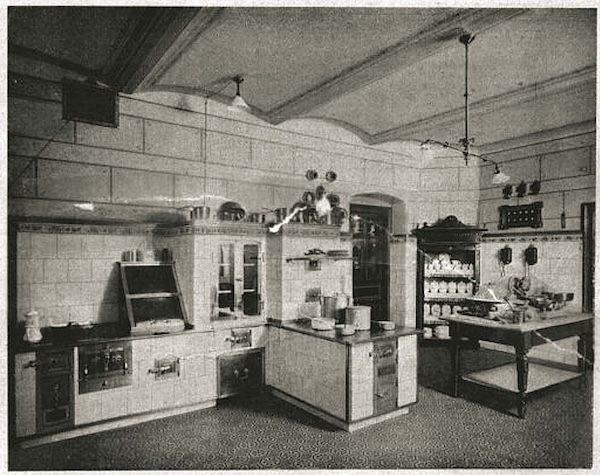
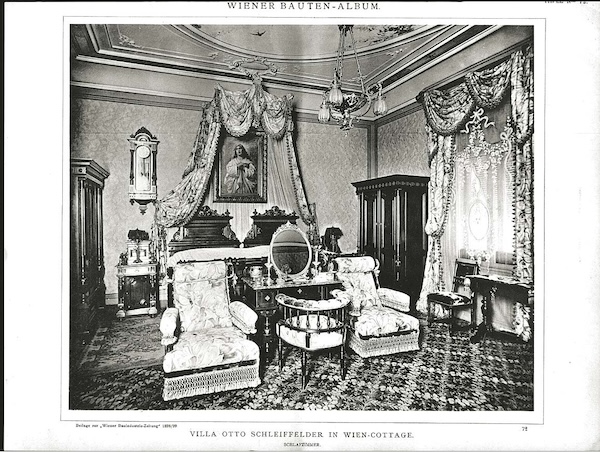
When Flow and Hearn went to Vienna in the late 1990s to inquire about the villa, the U.S. ambassador resisted the idea. “She said, ‘No, no. That’s where we have our parties,’” Flow recounts.
But the 1989 collapse of the Berlin Wall and 1991 dissolution of the Soviet Union had made staffing in cities such as Vienna and Berlin a political target. Flow says the ambassador added, “You know, there was an old senator over here hobbling around on a walker. He said too many Americans are living too high on the hog here in Vienna; we need to get rid of some of these properties.”
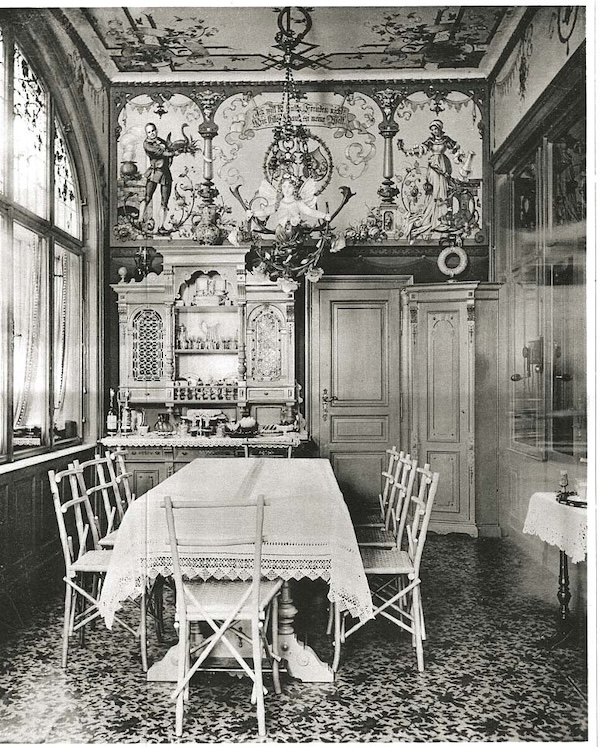
That frugal politician was powerful Sen. Jesse Helms, R-N.C., who in his youth had attended Wake Forest for a while.
“Tom said, ‘Did I mention we’re from North Carolina?’ About 15 minutes later, we bought the house,” Flow says with a chuckle.
A few weeks after the purchase in 1998, the Flows asked Hearn’s wife, Laura, to oversee extensive renovations and remodeling. “I went every three weeks for months and months and months,” says Laura Hearn (P ’02, ’03), who attended the Vienna celebration.
Flow House opened in fall 1999.
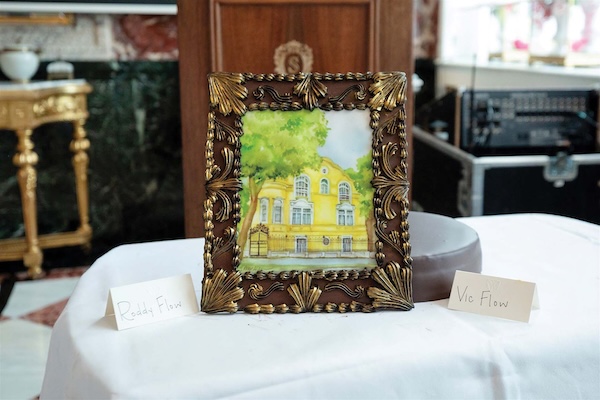
Read more at Early Flow House History and From the Villa Schleiffelder to the Flow House: The Journey of a Viennese Mansion
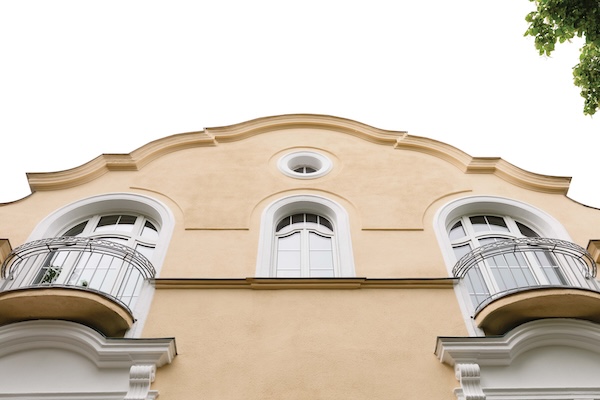
Alumni Reflect on How Flow House Offered Lessons Beyond Books
Those who lived in Flow House for a semester often gained life-changing perspectives, say alumni who traveled to Vienna for the 25th anniversary. These are a few of their stories.
Julie Hurd Talbert
Fall 1999
Julie Hurd Talbert (’00) of Winston-Salem arrived for Flow House’s first semester and says she fell under the spell of art history classes and Vienna’s museums, architecture, palaces and cathedrals.
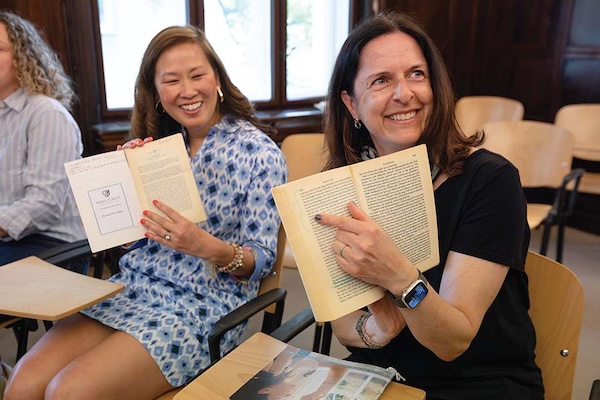
A communication major, she realized that beauty inspired her, so after graduation she pursued a career in interior design. Today, she chooses the furniture fabrics as upholstery merchandising manager for Lexington Home Brands, based in North Carolina.
“I’ve had so much fun,” Talbert says of her career. Fun also applies to the constant laughter with her group of Flow House alumni who have stayed close and celebrated one another’s weddings, birthdays and babies. “My group, they made the experience,” Talbert says.
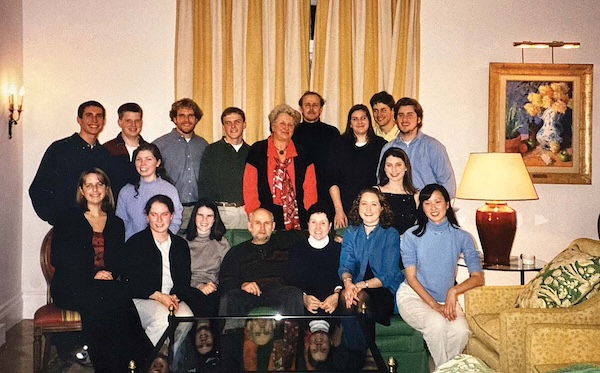
Alison Delaney
Fall 2002
Soon after arriving at Flow House in fall 2002, Alison Delaney (’04) and her classmates visited a little tavern with vines growing in the backyard. It was “a beautiful day, just sitting at this long picnic table and breathing in the fresh, summer August air, and thinking, ‘This is just going to be a really great semester.’” It was.
Besides having fun, she found new respect for her ingenuity.
Four days of classes left long weekends for travel but required
flexibility and persistence, says Delaney, of Mattituck, New York. She works in capital formation for business development at Arena Investors.
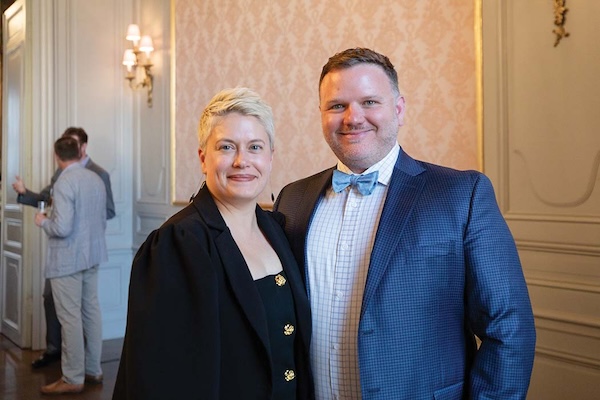
“We barely had the internet. … We didn’t have apps on our phone to book things. We just went with guidebooks and showed up at places or called ahead,” Delaney says.
She was especially proud of her first solo trip ever. “I didn’t go far. I went to Innsbruck. … And I did a hike (at Neuschwanstein Castle in Germany). … I had to speak the language and find my own place and entertain myself and be my own company. That was like a pretty big deal at the time.”
Every challenge prepared her for life after graduation,“experiencing a lot more things for the first time and being uncomfortable, but doing them anyway and figuring out how to succeed.”
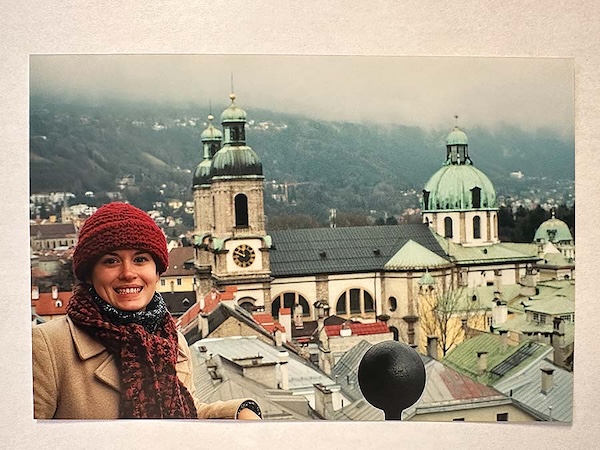
Matthew Kaden
Spring 2009
As Matthew Kaden (’11) walked into the balmy Vienna night after the gala dinner in May at the Kunsthistorisches Museum, his voice had dwindled to a cracked whisper from days of talking and laughing with his close circle of alumni.
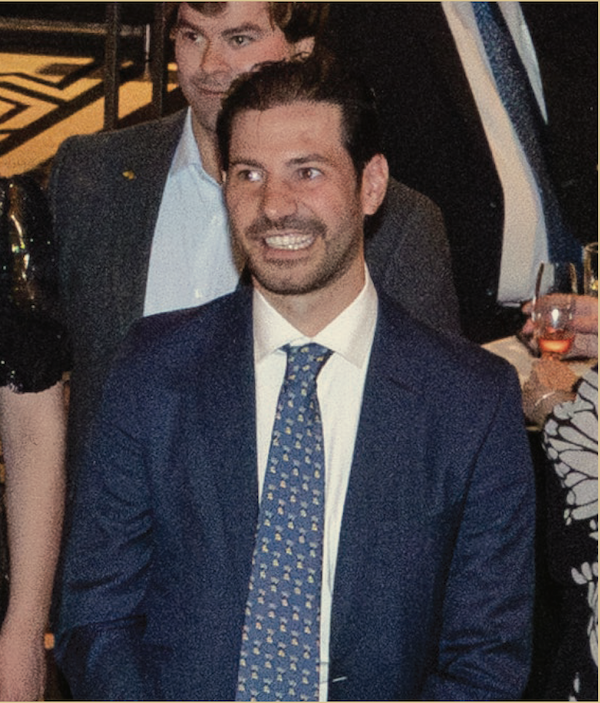
He found his handful of best friends for life at Flow House, he says, and the chance to gather again in Vienna was a treat. Back on campus after their semester away, they created CampusCakes together, a business that delivered Dewey’s goodies for birthdays and other occasions. He was best man at two of his friends’ weddings.
He recalls that his group had “some just crazy experiences, like we went running in the park with the (U.S.) ambassador.” The students invited him for dinner, and he reciprocated by having them as guests at a formal state dinner. “We sat down, all dressed up, name tags, the table set to the nines,” Kaden says.
Kaden, who lives in Belmar, New Jersey, is an executive director at UBS, a Swiss bank and investment firm, where speaking German sometimes comes in handy. His Vienna experience made him more open to working for a European company, with greater work-life balance than he says he had in previous jobs at Morgan Stanley and Goldman Sachs.
Mandy Emery
Spring 2011
Mandy Emery (’13, MA ’18) grew up in Charlotte with a large extended family there and in Winston-Salem, but she was determined to go out of state to college, study pre-med and travel the world. She had early acceptance offers as a junior.
But her mother insisted on a tour of Wake Forest, so she went — then she and her cousin slipped away from her mother and sister to peruse campus on their own. Alone at one point, as she sat in an empty Wait Chapel, a stack of papers hit the floor, and a shaft of window light shined on them. “It was a program from the medical school convocations. I literally felt like someone was beaming a spotlight on me,” she says.
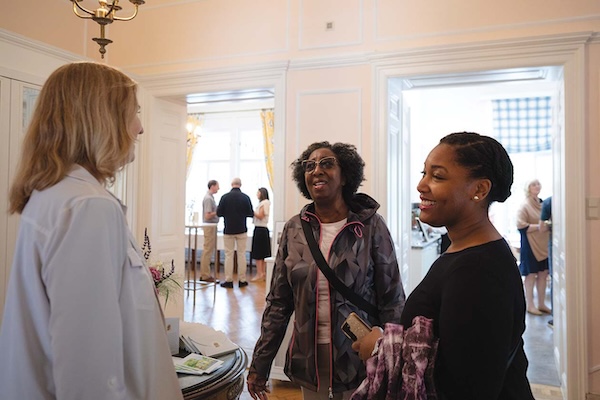
Then her cousin, with unusual emotion, told her that she would regret it the rest of her life if she didn’t apply to Wake Forest. She applied and didn’t leave North Carolina — but she did leave the country. A health communication course drew her to Flow House. She later decided against medical school and now works in Orlando, Florida, in benefits administration, which includes communicating with employees to help with health care benefits.
And she brought her mother, Gloria Hayes-Emery (P ’13), with her for the Vienna celebration.
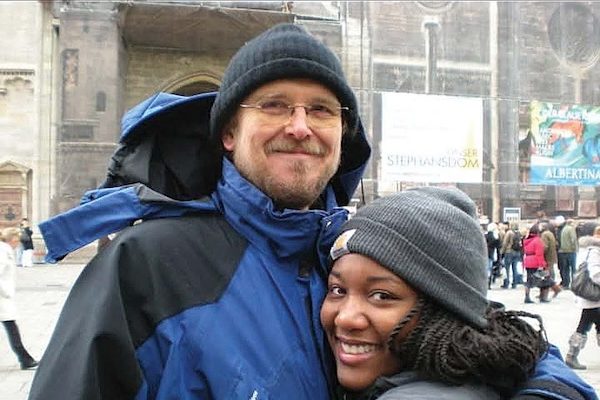
Retirement for ‘a model of the teacher-scholar’
Rebecca and Charles “Chuck” Thomas bid “auf wiedersehen” in Vienna as they retired in the summer from Wake Forest and the Flow House program, Rebecca (P ’04, ’12) as program director and a professor of German and Chuck (P ’04, ’12) as a history professor who also taught at Flow House.
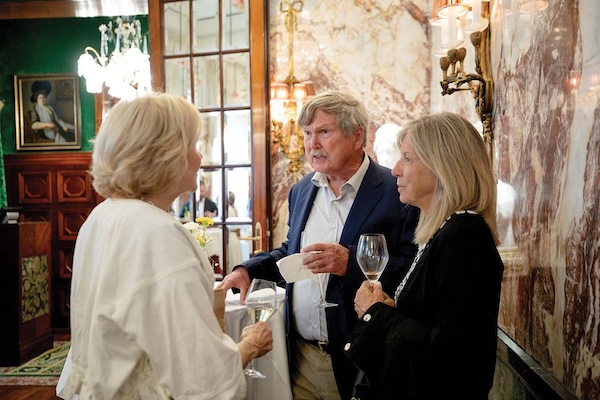
Associate Professor of German Grant McAllister (P ’26), the new program director, wrote of Rebecca Thomas that she is a model of the teacher-scholar. “For Rebecca, education was never confined to a schedule or a location (the story of her teaching German at home with a one-week-old baby boy is well-known!); it was a relationship between teacher and student, rooted in care, dedication, and respect.”
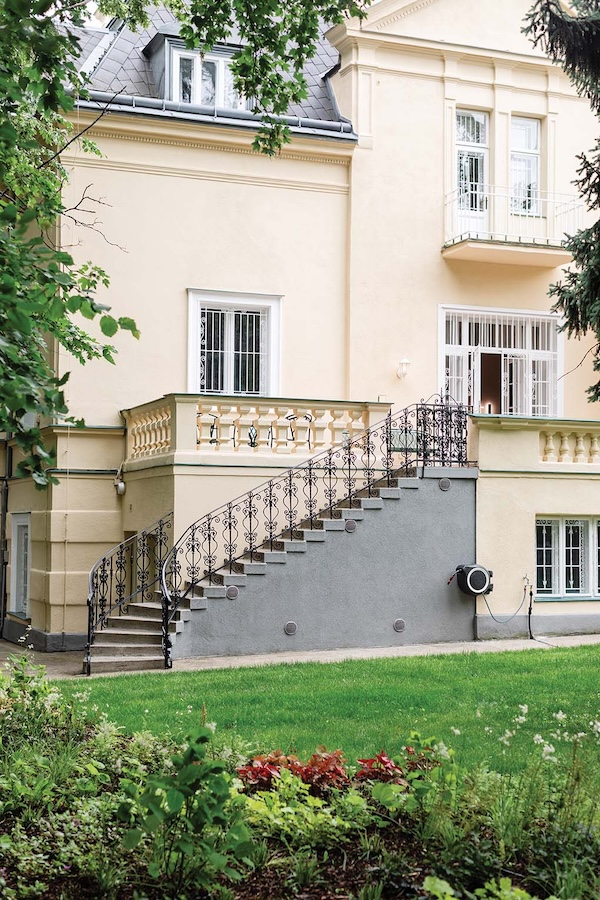
What the Thomases say they loved about teaching at Flow House was watching students grow in confidence and come alive to literature or history in places where it occurred.
“A topic may feel a little abstract when I’m in Greene Hall trying to get people excited about Austria,” says Rebecca Thomas. But in Vienna, she took students to read Austrian literature where the story is set. “They can see that this hundreds of years of history has culminated into these cultural artifacts.”
Professor Emeritus of German Larry West (P ’93)
• Inaugural program director 1999 to 2010
• Resident professor fall 1999, fall 2003
Professor Emeritus of Music David Levy
• Program director 2010 to 2019
• Resident professor spring 2000, fall 2004, spring 2012, fall 2018
Professor Emeritus of German Rebecca Thomas (P ’04, ’12)
• Program director 2019 to June 2025
• Resident professor fall 2002, fall 2007, fall 2023
Associate Professor of German Grant McAllister (P ’26)
• Program director beginning July 2025, after a year’s transition period with Rebecca Thomas
• Resident professor fall 2013
Alumni are excited to send emails sharing travel experiences that recall their Vienna memories, the Thomases say.
They are retiring to Winston-Salem, but they’ll return to Vienna to lead Wake Forest Lifelong Learning travel programs.
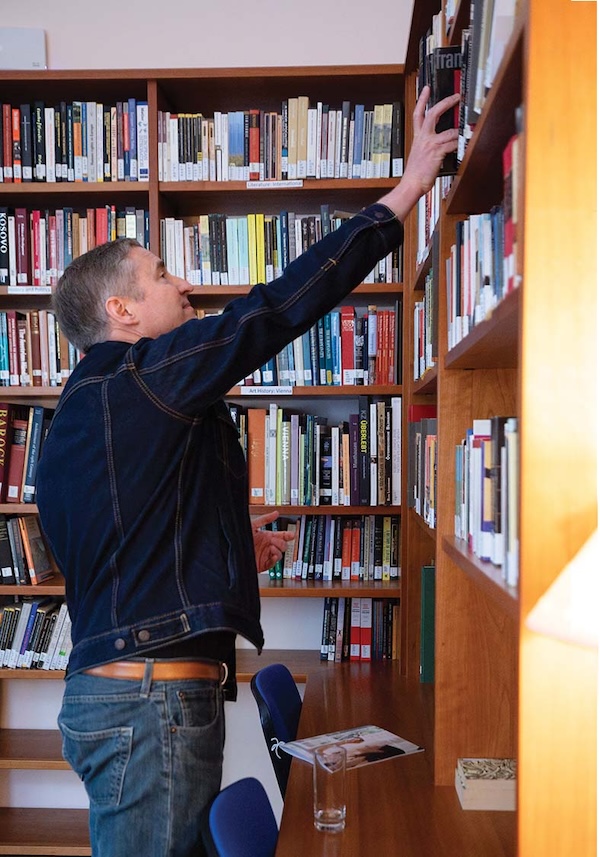
Read More
More reflections from alumni and faculty at bit.ly/FlowHouseReflections
More history of the Villa Schleiffelder that became Flow House at
bit.ly/FlowHouseHistory
Read Chuck Thomas’s book on Flow House history at bit.ly/ThomasFlowBook
Read Wake Forest Magazine’s 2023 story of Hitler’s impact on a German Jewish family, as documented in a soon-to-be-published book by five co-authors, including retired professors Rebecca and Chuck Thomas and new Flow House program director Grant McAllister, at bit.ly/TheLetters2024
